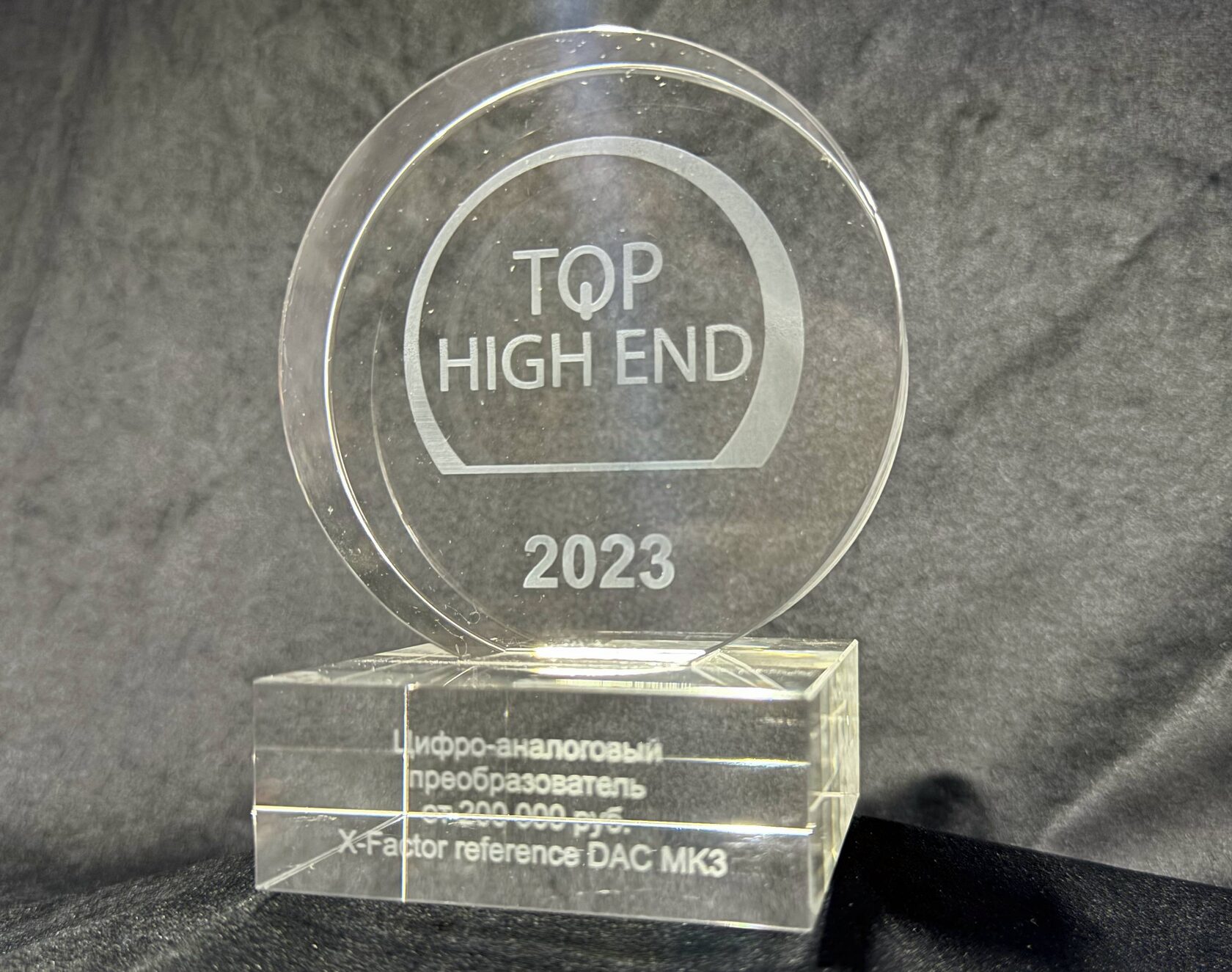
Digital-to-Analog converters

Digital-to-Analog converters
There such a multitude of different approaches used for high performance audio! Digital audio, analog audio, vacuum tube technology, or, let’s say, solid state technology… Multu-bit or single-bit DACs… You name it…
However, this seeming variety pushes the fundamental meaning of hardware’s raison d’etre – to create a strikingly palpable and beautiful musical presentation – aside. Although, all of it should be made to reproduce music, and not just an empty assortment of sounds.
Basically, this is our exact goal while designing and building our equipment: namely, to reproduce music the way that allows our team to fully appreciate it, and to invite you to share such an unforgettable experience with us!
However, this seeming variety pushes the fundamental meaning of hardware’s raison d’etre – to create a strikingly palpable and beautiful musical presentation – aside. Although, all of it should be made to reproduce music, and not just an empty assortment of sounds.
Basically, this is our exact goal while designing and building our equipment: namely, to reproduce music the way that allows our team to fully appreciate it, and to invite you to share such an unforgettable experience with us!
Digital-to-Analog converters… It’s obvious that such components are well known for more than thirty years and there has been a whole multitude of them made since the beginning of this genre of audio equipment.
Then, why does the world still need another one? Especially, considering that the third version of X-Factor DAC is currently available – do we really need another model?
The general ideas behind our own DAC were appearing gradually. During many years of our work with other DACs of the highest caliber, we elaborated, one by one, the list of requirements – both sonic and functional -that the DAC ideally should conform with. Unfortunately, there was not a single DAC model on the market that would comply with all our criteria. Such a situation is not new (as it was the same not a long time ago regarding audiophile-grade cables), this is why our engineering mind was constantly preoccupied with an idea to produce the best it can be DAC, the one which would finally meet all our sonic and functional goals.
We developed this no-holds-barred audiophile device based on the solutions which, as isolated techniques, do present in the DACs from other manufacturers, although they are never integrated in a single unit. Our disappointment with other products was related not only to the aspects of perceived sound quality, but to the aspects of the aforementioned DACs’ functionality as well.
As a result of long investigation and extended auditioning sessions via our reference audio system we finalized the overall design and its particular parts’ configurations to be used for all the building blocks of our own DAC.
Furthermore, the modular design of our DAC allows for future upgrades of the hardware to comply with possible changes in the upcoming musical software’s formats.
Our confidence is based upon the impressions from our meticulous auditioning of our DAC putting it against a whole variety of the most advanced DACs from the recognized leaders of the industry.
Our DAC consists of two chassis weighting a hundred and twenty (!) kilos – the DAC itself unit and the power supply unit.
Now, let’s look at its separate features.
The heated debates in audiophile community over which type of digital-to analog conversion scheme is better – either single-bit or multi-bit - are never-ending. In the meantime, the only way to correctly test advantages and disadvantages of each approach is to compare their sonic results within a single unit. Otherwise, there are too many other factors in concrete hardware’s design to affect the DAC’s overall sound quality.
| Up until now there was no such a possibility, but finally it’s here!
In our DAC we use simultaneously two types of conversion – single-bit and multi-bit. The former one is built with AK4497/4499 delta-sigma IC, while the latter one uses two multi-bit AD1865 in each channel, which allows to reach full 32-bit resolution in the multi-bit mode. Moreover, the user can choose between them on the fly. Besides, there is an automatic mode for the DAC, with the multi-bit mode set as a priority one (it’s our preference), however, when the DAC would register a DSD signal at its input it would automatically switch over to the single-bit mode.
This video graphically demonstrates the performance of the divided multi-bit converter which utilize subsequent summation of its outputs in analog domain.
Then, why does the world still need another one? Especially, considering that the third version of X-Factor DAC is currently available – do we really need another model?
The general ideas behind our own DAC were appearing gradually. During many years of our work with other DACs of the highest caliber, we elaborated, one by one, the list of requirements – both sonic and functional -that the DAC ideally should conform with. Unfortunately, there was not a single DAC model on the market that would comply with all our criteria. Such a situation is not new (as it was the same not a long time ago regarding audiophile-grade cables), this is why our engineering mind was constantly preoccupied with an idea to produce the best it can be DAC, the one which would finally meet all our sonic and functional goals.
We developed this no-holds-barred audiophile device based on the solutions which, as isolated techniques, do present in the DACs from other manufacturers, although they are never integrated in a single unit. Our disappointment with other products was related not only to the aspects of perceived sound quality, but to the aspects of the aforementioned DACs’ functionality as well.
As a result of long investigation and extended auditioning sessions via our reference audio system we finalized the overall design and its particular parts’ configurations to be used for all the building blocks of our own DAC.
Furthermore, the modular design of our DAC allows for future upgrades of the hardware to comply with possible changes in the upcoming musical software’s formats.
Our confidence is based upon the impressions from our meticulous auditioning of our DAC putting it against a whole variety of the most advanced DACs from the recognized leaders of the industry.
Our DAC consists of two chassis weighting a hundred and twenty (!) kilos – the DAC itself unit and the power supply unit.
Now, let’s look at its separate features.
The heated debates in audiophile community over which type of digital-to analog conversion scheme is better – either single-bit or multi-bit - are never-ending. In the meantime, the only way to correctly test advantages and disadvantages of each approach is to compare their sonic results within a single unit. Otherwise, there are too many other factors in concrete hardware’s design to affect the DAC’s overall sound quality.
| Up until now there was no such a possibility, but finally it’s here!
In our DAC we use simultaneously two types of conversion – single-bit and multi-bit. The former one is built with AK4497/4499 delta-sigma IC, while the latter one uses two multi-bit AD1865 in each channel, which allows to reach full 32-bit resolution in the multi-bit mode. Moreover, the user can choose between them on the fly. Besides, there is an automatic mode for the DAC, with the multi-bit mode set as a priority one (it’s our preference), however, when the DAC would register a DSD signal at its input it would automatically switch over to the single-bit mode.
This video graphically demonstrates the performance of the divided multi-bit converter which utilize subsequent summation of its outputs in analog domain.
| Important: we use separate single-bit chips for each channel, not a single one for both of them, as it’s routinely done in the vast majority of lesser aspiring devices.
Our DAC features a user selectable four different over-sampling frequencies’ modes and four different digital filters’ ones: all in all, it means a choice of seventeen different sound flavors. Including the mode when all the filtering algorithms and oversampling processing are switched off. Moreover, you can freely choose an appropriate selection for each of the DAC’s inputs and to store it in the unit’s non-volatile memory. The digital filter can be also turned off. All data processing is realized via a specialized floating-point 1 GHz SHARC 2165 DSP chip. Such an architecture allows to utilize in the DAC filters with arbitrary configurations, including custom ones, which a customer can order according to his, or her, sonic preferences.
The unit is equipped with a high-precision clock for external sound sources. BNC-type connectors are installed at the back panel of the DAC. The clock’s performance is very important for a DAC’s sound quality. To clock the source components from the DAC is the best way to improve sound quality via significantly lowering the incoming jitter.
There are four independent word-clock generator outputs in our DAC. Moreover, the device automatically identifies the incoming clock frequency and chooses optimal frequency of the etalon generator.
All the input connectors are positioned on the DAC’s back panel. Their concrete configuration can be chosen by the customer. Two USB connectors are the stock ones, while up to six RCA or XLR connectors can be configured according to the customer’s requirements. The RCA or XLR inputs can receive signals both using one cable (SPDIF-format) or two (SDIF-format). In the latter case, the DAC receives the incoming digital stream separately for the left and right channels, which allows to double the frequency of the incoming data.
There are several well-known audiophile companies that employ the same solution – DCS, WEISS, AURENDER, etc. This protocol is also widely used in professional audio. All in all, up to three SDIF inputs and up to six SPDIF inputs can be used with the DAC.
All analog circuitry at the digital conversion’s outputs is built around discrete elements and operates in deep Class A, and in the single-ended mode.
Suffice it to say that the output buffer operates at the idle current of 300 mA and its output impedance is just a few Ohms, with no negative feedback. In essence, it’s a small power amplifier! The frequency bandwidth of the DAC’s output circuitry is from 0 Hz to 50 MHz! Moreover, it demonstrated a solid stability while being connected to the most “complex” cables.
All capacitors in the DAC’s power supply are audiophile-grade and are shunted with best-quality film ones. The resistors we use in it are also the best they can be sonically.
The biggest attention during the units’ manufacturing process is paid to their PCB’s production. As a PCB’s single trace is the same signal transfer line as, for instance, an interconnect cable, it should be treated with as much care as any other significant overall design’s passive component, therefore, it is as important as any resistor or capacitor.
| Going through numerous A/B auditionings, it was decided to use ten(!) stacked 75 Micron-thick traces as a single trace for all the PCBs in the unit.
To remind you, as a rule, one or two 25 Micron-thick layers of traces are used in most of the PCBs. Naturally, using multiple layers of traces makes the boards very thick which impedes the ease of the soldering process and complicates the overall manufacturing. However, the sonic gains are well worth it. By the way, a less complicated and more budget-friendly regular PCB traces’ unit can be custom ordered.
Our DAC features a user selectable four different over-sampling frequencies’ modes and four different digital filters’ ones: all in all, it means a choice of seventeen different sound flavors. Including the mode when all the filtering algorithms and oversampling processing are switched off. Moreover, you can freely choose an appropriate selection for each of the DAC’s inputs and to store it in the unit’s non-volatile memory. The digital filter can be also turned off. All data processing is realized via a specialized floating-point 1 GHz SHARC 2165 DSP chip. Such an architecture allows to utilize in the DAC filters with arbitrary configurations, including custom ones, which a customer can order according to his, or her, sonic preferences.
The unit is equipped with a high-precision clock for external sound sources. BNC-type connectors are installed at the back panel of the DAC. The clock’s performance is very important for a DAC’s sound quality. To clock the source components from the DAC is the best way to improve sound quality via significantly lowering the incoming jitter.
There are four independent word-clock generator outputs in our DAC. Moreover, the device automatically identifies the incoming clock frequency and chooses optimal frequency of the etalon generator.
All the input connectors are positioned on the DAC’s back panel. Their concrete configuration can be chosen by the customer. Two USB connectors are the stock ones, while up to six RCA or XLR connectors can be configured according to the customer’s requirements. The RCA or XLR inputs can receive signals both using one cable (SPDIF-format) or two (SDIF-format). In the latter case, the DAC receives the incoming digital stream separately for the left and right channels, which allows to double the frequency of the incoming data.
There are several well-known audiophile companies that employ the same solution – DCS, WEISS, AURENDER, etc. This protocol is also widely used in professional audio. All in all, up to three SDIF inputs and up to six SPDIF inputs can be used with the DAC.
All analog circuitry at the digital conversion’s outputs is built around discrete elements and operates in deep Class A, and in the single-ended mode.
Suffice it to say that the output buffer operates at the idle current of 300 mA and its output impedance is just a few Ohms, with no negative feedback. In essence, it’s a small power amplifier! The frequency bandwidth of the DAC’s output circuitry is from 0 Hz to 50 MHz! Moreover, it demonstrated a solid stability while being connected to the most “complex” cables.
All capacitors in the DAC’s power supply are audiophile-grade and are shunted with best-quality film ones. The resistors we use in it are also the best they can be sonically.
The biggest attention during the units’ manufacturing process is paid to their PCB’s production. As a PCB’s single trace is the same signal transfer line as, for instance, an interconnect cable, it should be treated with as much care as any other significant overall design’s passive component, therefore, it is as important as any resistor or capacitor.
| Going through numerous A/B auditionings, it was decided to use ten(!) stacked 75 Micron-thick traces as a single trace for all the PCBs in the unit.
To remind you, as a rule, one or two 25 Micron-thick layers of traces are used in most of the PCBs. Naturally, using multiple layers of traces makes the boards very thick which impedes the ease of the soldering process and complicates the overall manufacturing. However, the sonic gains are well worth it. By the way, a less complicated and more budget-friendly regular PCB traces’ unit can be custom ordered.

Ten-layer board in cross-section
Also, our designers were as meticulous while choosing a soldering formula. Following the same no-holds-barred approach, the solder was selected according to its best sonic result.
It happened to be a leadless refractory solder with no flux. It’s a very difficult one to work with, nevertheless, we decided to use it because we are always driven with the priority of the sound quality over any practical considerations that can be.
The chassis-mount connectors are made in Japan by Furutech, the chassis-mount power supply connectors are Russian military-spec connectors utilizing silver-coated male and female contact groups.
All DAC’s main switching is controlled via its multi-functional remote control milled from an aluminum billet. The same remote-control unit can be used with the forthcoming X-Factor power amplifier.
Some additional retro-fit options for the DAC’s users, such as a volume control with discrete resistors, are currently available too.
The DAC chassis’ quality is worth of a separate mention. As the chassis of the most advanced audio equipment plays a lot of different roles, its design and the quality of its production is very important, especially considering its protective effects on the super-delicate DAC innards – both in the domain of their protection from parasitic mechanical vibrations, and in the domain of shielding of electro-magnetic fields (in both direction – both from within, and from without).
The DAC’s own chassis and its power supply chassis are made using a combination of two metals. The inner chassis – with all the circuitry installed in it – is made out of steel, while the outer chassis is made out of aluminum sheets (16-mm in thickness). Such combination of magnetic and non-magnetic materials allows for the best shielding, both from external electro-magnetic radiation to the DAC’s elements inside, and for the best shielding of the nearby audio equipment from the electro-magnetic fields generated by the DAC itself. It should be noted that the analog circuitry within the DAC is additionally shielded from the digital one.
Moreover, the super-sturdy DAC’s chassis, in combination with its special mechanical noise absorbing feet, provides an absolute level of control over some external parasitic mechanical vibrations.
The DAC’s power supply unit is connected to the DAC unit with three separate cables.
The cables’ construction was designed with their shielding and mechanical vibration protection in mind, because they are as important elements of the whole DAC construction as all the rest.
Broadly speaking, the power supply considerations required a lot of attention, as the output signal is, eventually, a “modulated power supply”.
As a result of such power supply design priority, each building block of the DAC is fed double-regulated power from its own power transformer.
This (some would think, overkill, from purely engineering standpoint) solution, nevertheless, has some subjectively clearly perceivable sonic gains. Moreover, all power transformers (there are 18 of them totally) are designed to 0.6 T specification (usually such transformers are designed to 2 T magnetic flux spec), which allows to use a transformer’s core in a less intensive mode, which, in its turn, significantly lowers the transformer electro-magnetic radiation and its sensitivity to the AC power supply voltage’s stability (although, it does increase the transformer’s dimensions and weight). All the transformers in this DAC are thoroughly shielded!
Finally, as “an icing on the case”, there are two power cords connecting the power supply to the AC power outlets – one is for the digital circuitry, and the other one is for the analog one.
Such solution allows for the most versatile options while using separate power conditioners and AC power filters, and as a result of it, it provides the most robust isolation of the digital part of the DAC’s circuitry from the analog one.
| We have been always auditioning - and are still continuing to do so - our product against some of the most recognized and respected competition.
It happened to be a leadless refractory solder with no flux. It’s a very difficult one to work with, nevertheless, we decided to use it because we are always driven with the priority of the sound quality over any practical considerations that can be.
The chassis-mount connectors are made in Japan by Furutech, the chassis-mount power supply connectors are Russian military-spec connectors utilizing silver-coated male and female contact groups.
All DAC’s main switching is controlled via its multi-functional remote control milled from an aluminum billet. The same remote-control unit can be used with the forthcoming X-Factor power amplifier.
Some additional retro-fit options for the DAC’s users, such as a volume control with discrete resistors, are currently available too.
The DAC chassis’ quality is worth of a separate mention. As the chassis of the most advanced audio equipment plays a lot of different roles, its design and the quality of its production is very important, especially considering its protective effects on the super-delicate DAC innards – both in the domain of their protection from parasitic mechanical vibrations, and in the domain of shielding of electro-magnetic fields (in both direction – both from within, and from without).
The DAC’s own chassis and its power supply chassis are made using a combination of two metals. The inner chassis – with all the circuitry installed in it – is made out of steel, while the outer chassis is made out of aluminum sheets (16-mm in thickness). Such combination of magnetic and non-magnetic materials allows for the best shielding, both from external electro-magnetic radiation to the DAC’s elements inside, and for the best shielding of the nearby audio equipment from the electro-magnetic fields generated by the DAC itself. It should be noted that the analog circuitry within the DAC is additionally shielded from the digital one.
Moreover, the super-sturdy DAC’s chassis, in combination with its special mechanical noise absorbing feet, provides an absolute level of control over some external parasitic mechanical vibrations.
The DAC’s power supply unit is connected to the DAC unit with three separate cables.
The cables’ construction was designed with their shielding and mechanical vibration protection in mind, because they are as important elements of the whole DAC construction as all the rest.
Broadly speaking, the power supply considerations required a lot of attention, as the output signal is, eventually, a “modulated power supply”.
As a result of such power supply design priority, each building block of the DAC is fed double-regulated power from its own power transformer.
This (some would think, overkill, from purely engineering standpoint) solution, nevertheless, has some subjectively clearly perceivable sonic gains. Moreover, all power transformers (there are 18 of them totally) are designed to 0.6 T specification (usually such transformers are designed to 2 T magnetic flux spec), which allows to use a transformer’s core in a less intensive mode, which, in its turn, significantly lowers the transformer electro-magnetic radiation and its sensitivity to the AC power supply voltage’s stability (although, it does increase the transformer’s dimensions and weight). All the transformers in this DAC are thoroughly shielded!
Finally, as “an icing on the case”, there are two power cords connecting the power supply to the AC power outlets – one is for the digital circuitry, and the other one is for the analog one.
Such solution allows for the most versatile options while using separate power conditioners and AC power filters, and as a result of it, it provides the most robust isolation of the digital part of the DAC’s circuitry from the analog one.
| We have been always auditioning - and are still continuing to do so - our product against some of the most recognized and respected competition.
| Comparative listening of the x-factor DAC with one of the best DAC's on the market in our reference system/
Other information and video about our product you can see here.
Our awards
X-Factor Mk III has twice won the TOP HIGH END 2022-2023 award in the category of
“Digital-to-analog converter from 200,000 rubles”.
“Digital-to-analog converter from 200,000 rubles”.


